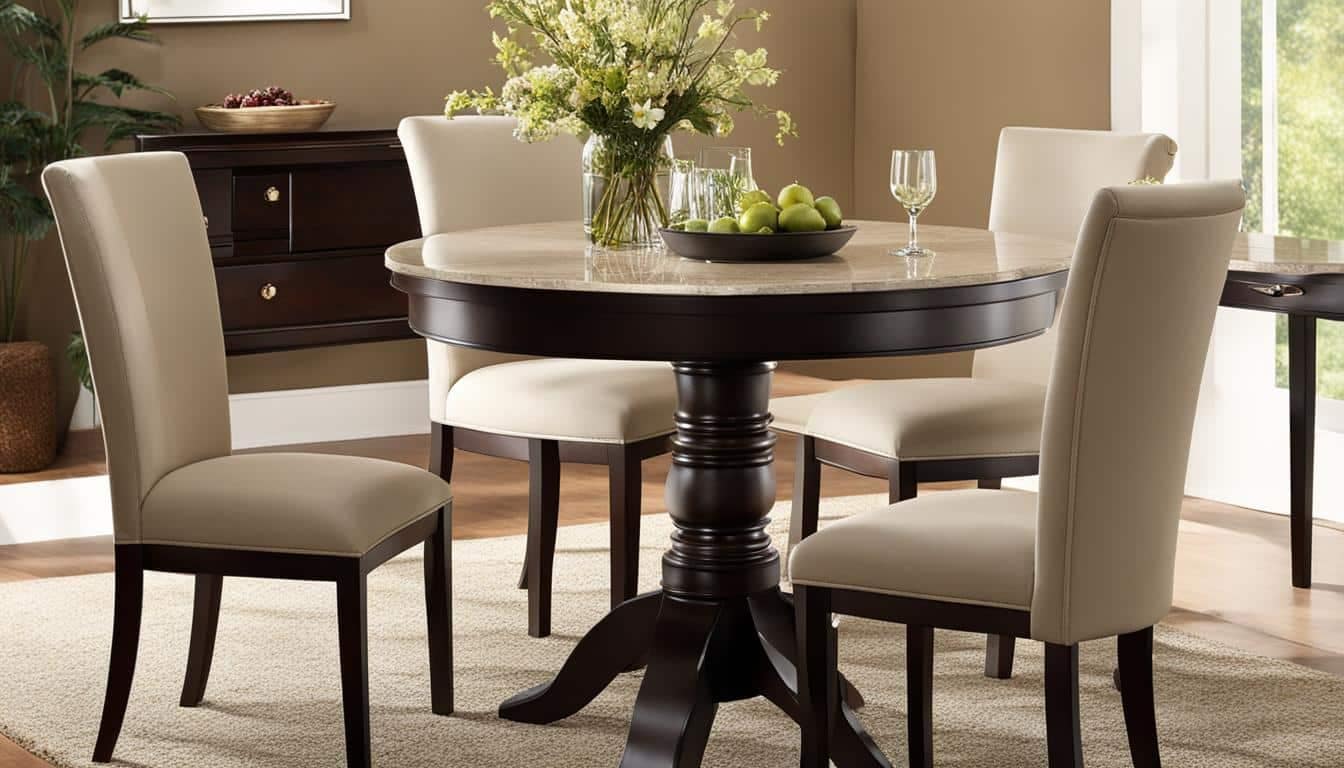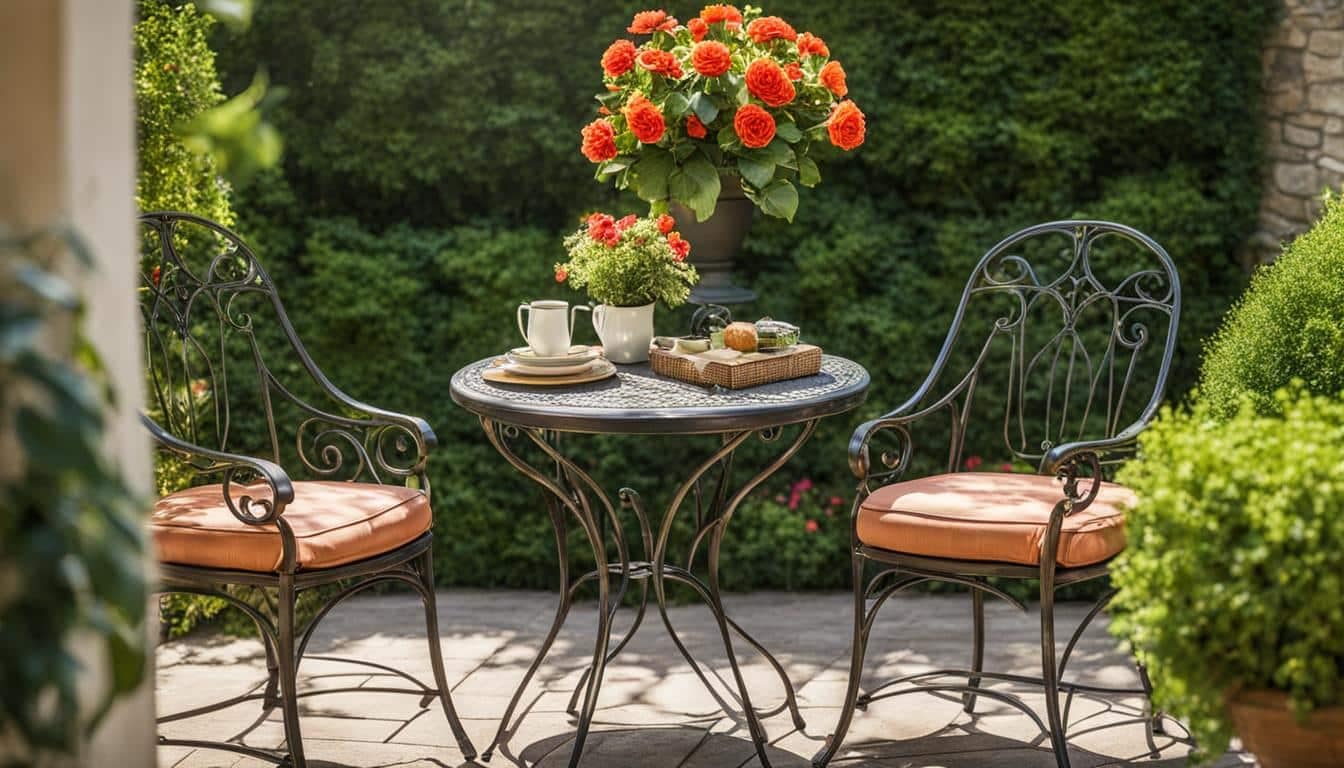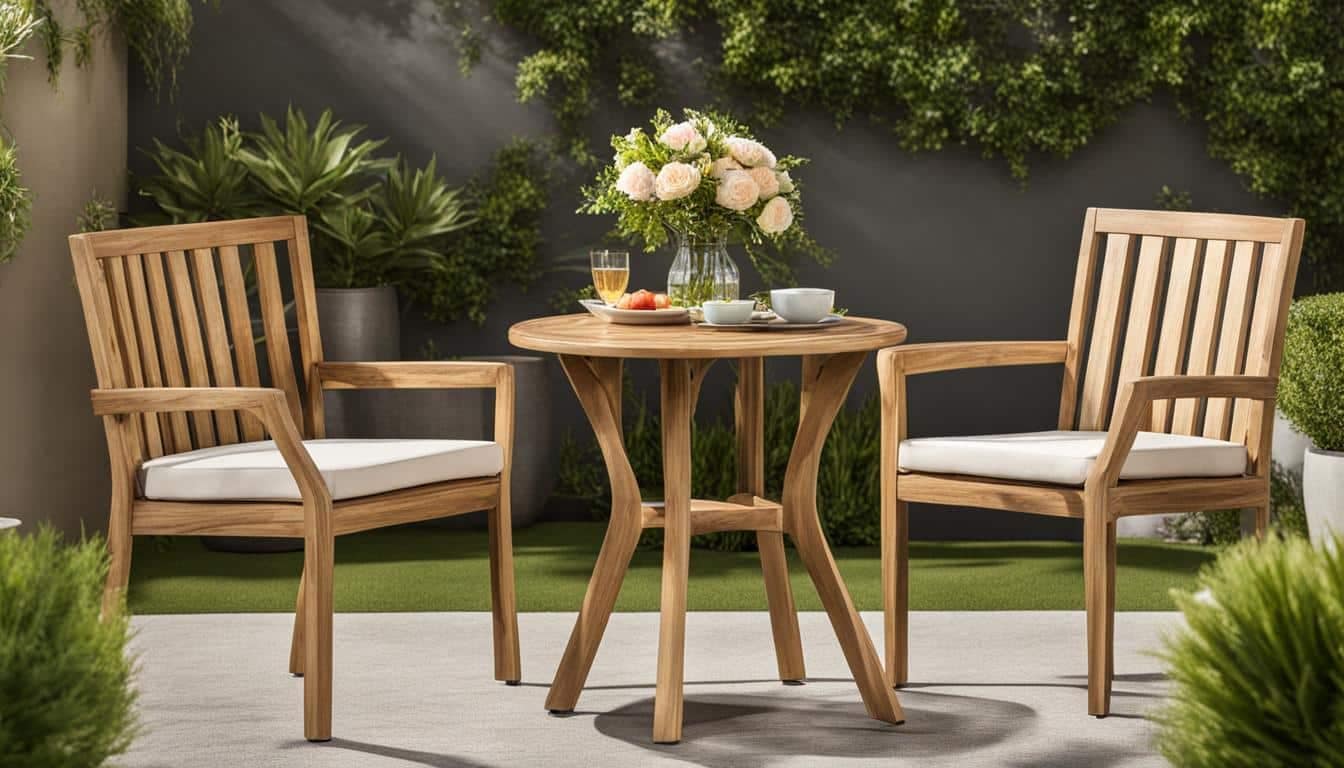One of the steps you can take to enhance the natural appearance and quality of your outdoor wood furniture is to apply a wood oil. This helps protect the wood from the elements, prolonging its lifespan and emphasizing the wood grain. There are several types of garden furniture oil that can be used, including teak oil, tung oil, and Danish oil. Teak oil is generally considered the best oil for treating wooden garden furniture as it provides year-round weather protection and penetrates deeply into the wood pores. Tung oil is ideal for natural oak or wood with similar properties, offering resistance against water and chemicals. Danish oil, while not as durable, provides waterproof protection and is easy to apply. Avoid using linseed oil, as it does not provide sufficient weather protection.
Key Takeaways:
- Applying wood oil protects outdoor wood furniture from the elements and prolongs its lifespan.
- Teak oil is considered the best oil for outdoor wood furniture due to its year-round weather protection and deep penetration into wood pores.
- Tung oil is ideal for natural oak or wood with similar properties as it provides water and chemical resistance.
- Danish oil offers waterproof protection and is easy to apply, but it may not be as durable as other oils.
- Avoid using linseed oil as it does not provide sufficient weather protection for outdoor wood furniture.
How to Apply Wood Oil to Outdoor Furniture
To keep your outdoor wood furniture in optimal condition, regular oiling is essential. This helps protect the wood from the elements and enhances its natural beauty. Follow these simple steps to effectively apply wood oil to your outdoor furniture:
- Clean the wood: Before applying the oil, ensure that the furniture is clean and free from dust, dirt, and grease. If needed, sand or clean the surface beforehand to create a smooth and receptive base.
- Choose the right oil: Select the appropriate outdoor wood furniture oil, such as teak oil or tung oil, based on the type of wood and the level of protection required. These oils are known for their weather resistance and deep penetration into wood pores.
- Apply the oil: Shake the oil well and use a lint-free cotton cloth, brush, or roller to apply a thin and even layer of oil to the wood surface. Work in the direction of the wood grain, ensuring full coverage.
- Massage and absorb: Massage the oil into the wood using circular motions until it is fully absorbed. Continue rubbing until the surface appears dry. This ensures that the wood absorbs the oil and maximizes its protective benefits.
- Polish and maintain: After 24 hours, you can lightly polish the surface with a clean cotton cloth to bring out the wood’s natural shine. Regularly oil your outdoor furniture every year or two to maintain its protection and appearance.
By following these simple steps, you can ensure that your outdoor wood furniture remains in excellent condition for years to come. Regular oiling will help protect the wood from weather damage and maintain its natural beauty. Remember to choose the right oil for your specific needs and apply it correctly for the best results. With proper care, your outdoor furniture will continue to bring you enjoyment and comfort.
Types of Outdoor Wood Finishes
When it comes to treating outdoor wood furniture, there are various types of finishes available. Each type of finish offers different benefits and application techniques. Here are some popular options:
- Polyurethane: This durable plastic resin is available in different sheens and provides long-lasting protection for your outdoor wood furniture. It is resistant to water, scratches, and UV rays.
- Lacquer: Lacquer is a high-gloss finish made by dissolving tree sap in alcohol or turpentine. It provides a smooth and shiny surface, but it may not be as durable as other finishes.
- Varnish: Made up of drying oil, resin, and a solvent, varnish offers high water and UV resistance. It provides a protective layer that enhances the natural beauty of the wood.
- Epoxy: Epoxy is a durable finish often applied before varnish or lacquer. It forms a strong bond with the wood and provides added protection against moisture and wear.
It’s important to choose a finish that is appropriate for your specific project and follow the manufacturer’s instructions for application. Consider factors such as durability, desired appearance, and level of protection needed for your outdoor wood furniture.
Factors to Consider:
- Weather resistance
- Durability
- Appearance
- Application technique
By selecting the right outdoor wood finish, you can ensure that your furniture is well-protected and looks great for years to come.
By implementing these maintenance practices, you can extend the lifespan of your outdoor wood furniture and ensure that it remains in excellent condition for years to come. Remember to clean regularly, reapply protective finishes as needed, and protect the furniture from the weather when necessary. With proper care, your outdoor wood furniture will continue to enhance your outdoor space and provide years of enjoyment.
Conclusion
As you conclude your journey of oiling outdoor wood furniture, you have gained valuable insights on how to maintain and protect your beloved pieces. By following this outdoor furniture oiling guide, you can ensure longevity and enhance the natural beauty of your wood furniture.
Remember, when it comes to choosing the best oil for outdoor wood furniture, teak oil and tung oil are highly recommended options. These oils provide year-round weather protection and penetrate deeply into the wood, emphasizing its unique grain.
Taking the time to apply the oil correctly and regularly maintaining your furniture will pay off in the long run. Keep your outdoor wood furniture clean, reapply oil as needed, and consider using a protective cover during colder months. With these simple steps, you can enjoy your outdoor furniture for years to come.
FAQ
How often should I oil my outdoor wood furniture?
Regular oiling is recommended every year or two to maintain the protection and appearance of the wood.
Which type of wood oil should I use on my outdoor furniture?
Teak oil is generally considered the best oil for treating wooden garden furniture as it provides year-round weather protection and penetrates deeply into the wood pores. Tung oil is ideal for natural oak or wood with similar properties, offering resistance against water and chemicals. Danish oil, while not as durable, provides waterproof protection and is easy to apply. Avoid using linseed oil, as it does not provide sufficient weather protection.
How do I apply wood oil to my outdoor furniture?
Make sure the wood is clean and free of dust and grease. If necessary, sand or clean the furniture beforehand. Shake the oil well and apply it with a lint-free cotton cloth, brush, or roller, ensuring an even application. Massage the oil into the wood until it is completely absorbed and appears dry. After 24 hours, you can polish the surface with a cotton cloth.
What types of finishes can I use on outdoor wood furniture?
Some popular options include polyurethane, lacquer, varnish, and epoxy. Each finish has its own application techniques and drying times. Polyurethane is a durable plastic resin that provides long-lasting protection. Lacquer is a high-gloss finish made by dissolving tree sap in alcohol or turpentine. Varnish is made up of drying oil, resin, and a solvent, providing high water and UV resistance. Epoxy is a durable finish often applied before varnish or lacquer. It’s important to choose a finish that is appropriate for your specific project and follow the manufacturer’s instructions for application.
How should I maintain my outdoor wood furniture?
Regular maintenance includes cleaning the furniture regularly to remove dirt and debris, reapplying finish as needed to maintain protection, and protecting the furniture from the weather by using a cover during colder months. It’s also important to avoid covering certain types of wood, such as acacia, as they need to be able to breathe.








